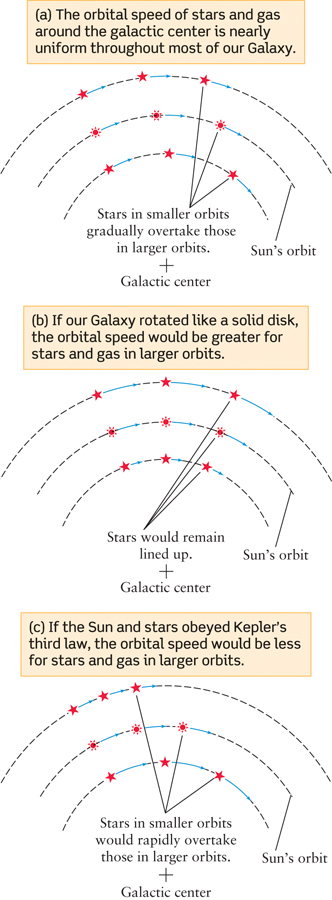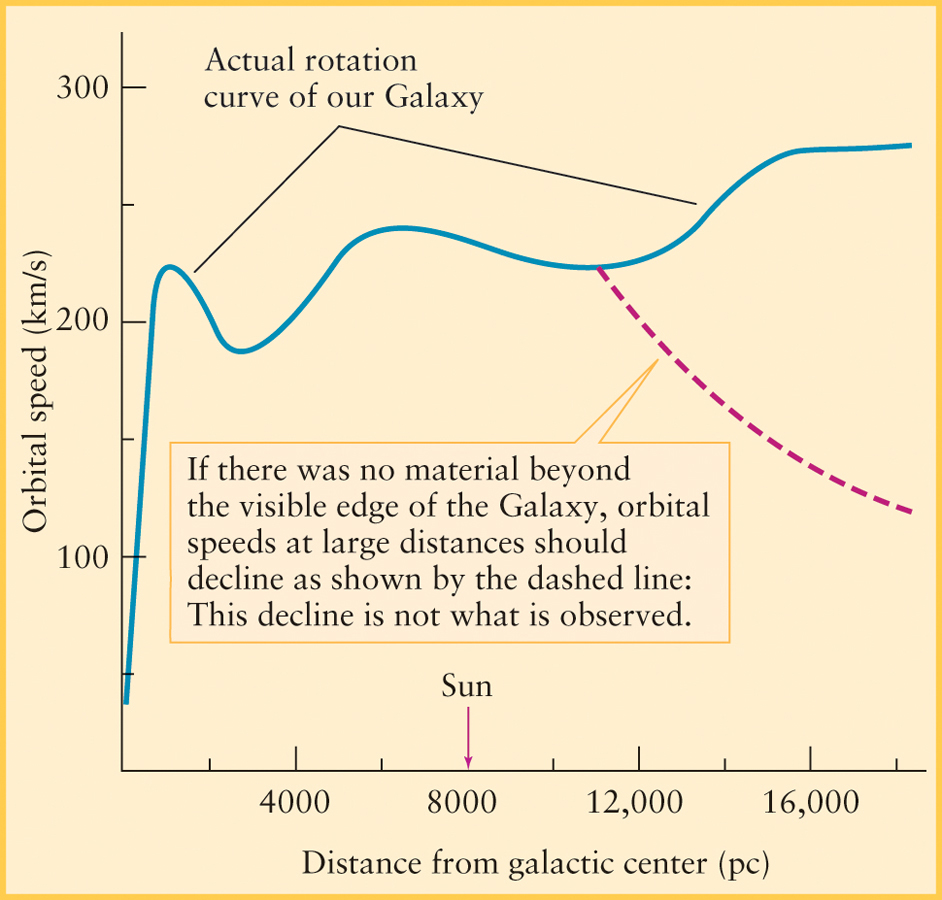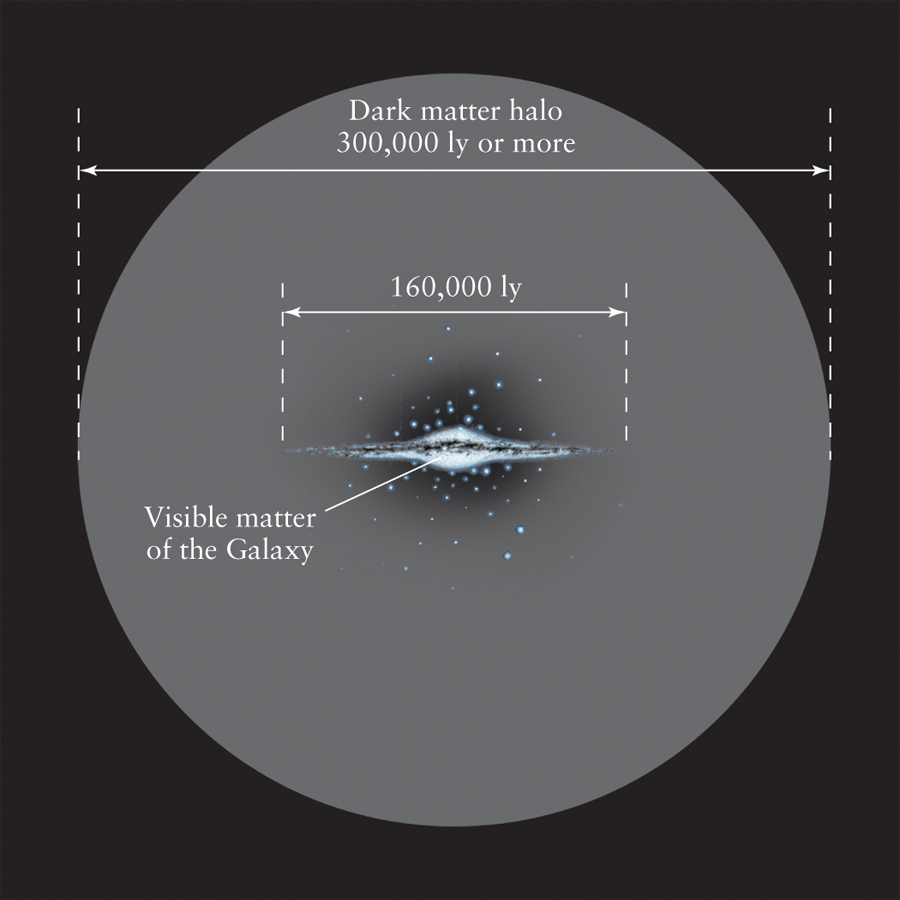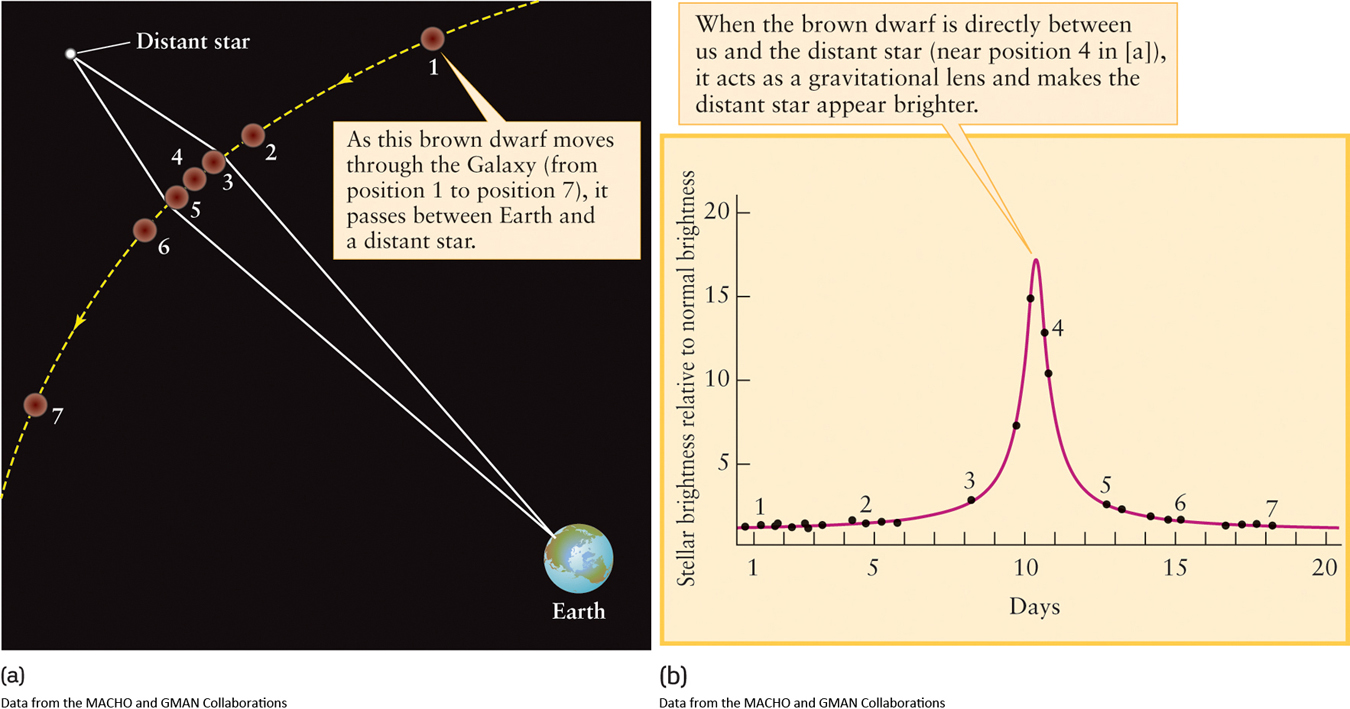13-4 Measuring the rotation of our Galaxy reveals the presence of dark matter
 Go to Video 13-3
Go to Video 13-3
The spiral arms in the disk of our Galaxy suggest that the disk rotates. This means that the stars, gas, and dust in our Galaxy are all orbiting the galactic center. Indeed, if this were not the case, mutual gravitational attraction would cause the entire Galaxy to collapse into the galactic center. In the same way, the Moon is kept from crashing into Earth and the planets from crashing into the Sun because of their motion around their orbits.
Measuring the rotation of our Galaxy accurately is a difficult business. But such challenging measurements have been made, as we shall see, and the results led to a remarkable conclusion: Most of the mass of the Galaxy is in the form of dark matter, a mysterious sort of material that emits no light at all.
Measuring How the Milky Way Rotates
Radio observations of 21-cm light from hydrogen gas across our Galaxy provide important clues about our Galaxy’s rotation. Doppler shift measurements of this long-wavelength light indicate that stars and gas all orbit in the same direction around the galactic center, just as the planets all orbit in the same direction around the Sun. Measurements also show that the orbital speed of stars and gas about the galactic center is fairly uniform throughout much of the Galaxy’s disk (Figure 13-17). As a result, stars inside the Sun’s orbit complete a trip around the galactic center more quickly than the Sun because the stars have a shorter distance to travel. Conversely, stars outside the Sun’s orbit take longer to go once around the galactic center because they have farther to travel. As seen by Earth-based astronomers moving along with the Sun, stars inside the Sun’s orbit overtake and pass us, while we overtake and pass stars outside the Sun’s orbit (Figure 13-17a).

CAUTION
Note that when we say that objects in different parts of the Galaxy orbit at the same speed, we do not mean that the Galaxy rotates like a solid disk. All parts of a rotating solid disk—a CD or DVD, for example—take the same time to complete one rotation. Because the outer part of the disk has to travel around a larger circle than the inner part, the speed (distance per time) is greater in the outer part (Figure 13-17b). By contrast, the orbital speed of material in our Galaxy is roughly the same at all distances from the galactic center.
The most familiar examples of orbital motion are the motions of the planets around the Sun. The farther a planet is from the Sun, the less gravitational force it experiences and the slower the speed it needs to have to remain in orbit. The same would be true for the orbits of stars and gas in the Galaxy if they were held in orbit by a single, massive object at the galactic center (Figure 13-17c). Hence, the 21-cm observations of our Galaxy, which show that the speed does not decrease with increasing distance from the galactic center, demonstrate that there is no such single, massive object holding objects in their galactic orbits.
Instead, what keeps a star in its orbit around the center of the Galaxy is the combined attraction of gravity exerted on it by all of the mass, including stars, gas, and dust that lies within the star’s orbit. It turns out that the gravitational attraction from the combined matter outside a star’s orbit has little or no net effect on the star’s motion around the galactic center. This gives us a tool for determining the Galaxy’s mass and how that mass is distributed.
313
Question
ConceptCheck 13-8: Which would have a greater impact on changing the length of time it takes the Sun to orbit the galactic center adding more stars to the galactic center or adding more stars to the galactic halo?
The Sun’s Orbital Motion and the Mass of the Galaxy
An important example is the orbital motion of the Sun (and the rest of the solar system along with it) around the center of the Galaxy. If we know the average distance from the galactic center (semimajor axis) and period of the Sun’s orbit, we can use Newton’s form of Kepler’s third law to determine the mass of that portion of the Galaxy that lies within the orbit. We saw earlier that the Sun is about 25,000 light-years from the galactic center; this is the semimajor axis of the Sun’s orbit. The orbit is in fact nearly circular, so we can regard 25,000 ly as the radius r of the orbit. In one complete trip around the Galaxy, the Sun travels a distance equal to the circumference of its orbit, which is 2πr. The time required for one orbit, or orbital period P, is equal to the distance traveled divided by the Sun’s orbital speed v:
Period of the Sun’s orbit around the galactic center

Unfortunately, we cannot tell the Sun’s orbital speed from 21-cm observations, since these reveal only how fast things are moving relative to the Sun. Instead, we need to measure how the Sun is moving relative to a background that is not rotating along with the rest of the Galaxy. Such a background is provided by distant galaxies beyond the Milky Way and by the globular clusters. (Since globular clusters lie outside the plane of the Galaxy, they do not take part in the rotation of the disk, as shown in Figure 13-8.) By measuring the Doppler shifts of these objects and averaging their velocities, astronomers deduce that the Sun is moving along its orbit around the galactic center at about 220 km/s—about 790,000 kilometers per hour or 490,000 miles per hour!

Using this information, we find that the Sun’s orbital period is

Traveling at 790,000 km/h, it takes the Sun about 220 million years to complete one trip around the Galaxy. As a point of reference, in the 65 million years since the demise of the dinosaurs, our solar system has traveled less than a third of the way around its orbit. The Galaxy is a very large place!
Question
CalculationCheck 13-2: Since it formed 4.57 billion years ago, how many trips around the Galaxy has the Sun made?
Rotation Curves and the Mystery of Dark Matter
Stars in our Galaxy move faster than we expect, suggesting more mass is present than we can see.
In recent years, astronomers have been astonished to discover how much matter may lie outside the Sun’s orbit. The clues come from 21-cm light emitted by hydrogen in spiral arms that extend to the outer reaches of the Galaxy. Because we know the true speed of the Sun, we can convert the Doppler shifts of this radiation into actual speeds for the spiral arms. This calculation gives us a rotation curve, a graph of the speed of galactic rotation measured outward from the galactic center (Figure 13-18). We would expect that for gas clouds beyond the confines of most of the Galaxy’s mass, the orbital speed should decrease with increasing distance from the Galaxy’s center, just as the orbital speeds of the planets decrease with increasing distance from the Sun (see Figure 13-17c). But as Figure 13-18 shows, the Galaxy’s rotation curve is quite flat, indicating roughly uniform orbital speeds well beyond the visible edge of the galactic disk.
To explain these nearly uniform orbital speeds in the outer parts of the Galaxy, astronomers conclude that a large amount of matter must lie outside the Sun’s orbit. When this matter is included, the total mass of our Galaxy could exceed 1012 M⊙ or more, of which about 10% is in the form of stars. This implies that our Galaxy contains roughly 200 billion stars.
These observations lead to a profound mystery. Stars, gas, and dust account for only about 10% of the Galaxy’s total mass. What, then, makes up the remaining 90% of the matter in our Galaxy? Whatever it is, it is dark. It does not show up on photographs, nor indeed in images made in any part of the electromagnetic spectrum. This unseen material, which is by far the predominant constituent of our Galaxy, is called dark matter. We sense its presence only through its gravitational influence on the orbits of stars and gas clouds.
314
CAUTION
Be careful not to confuse dark matter with dark nebulae. A dark nebula like the one in Figure 11-2 emits no visible light, but does radiate at longer wavelengths. By contrast, no electromagnetic radiation of any kind has yet been discovered coming from dark matter.
Observations of star groupings outside the Milky Way suggest that our Galaxy’s dark matter forms a spherical halo centered on the galactic nucleus, like the halo of globular clusters and high-velocity stars shown in Figure 13-8. However, the dark matter halo is much larger; it may extend to a distance of 326,000 ly to 652,000 ly from the center of our Galaxy, some 2 to 4 times the extent of the visible halo (Figure 13-19). Analysis of the rotation curve in Figure 13-18 shows that the density of the dark matter halo decreases with increasing distance from the center of the Galaxy.

Question
ConceptCheck 13-9: How would the motion of stars at the edge of our Galaxy be different if there were no dark matter present?
Dark Matter Speculations
What is the nature of this mysterious dark matter? One proposal is that the dark matter halo is composed, at least in part, of dim objects with masses less than 1 M⊙. These objects, which could include brown dwarfs, white dwarfs, or black holes, are called massive compact halo objects, or MACHOs. Astronomers have searched for MACHOs by monitoring the light from distant stars. If a MACHO passes between us and the star, its gravity will bend the light coming from the star. As Figure 13-20 shows, the MACHO’s gravity acts like a lens that focuses the light from the star.
Astronomers have indeed detected MACHOs in this way, but not nearly enough to completely solve the dark matter mystery. MACHOs with very low mass (10−6 M⊙ to 0.1M⊙ each) do not appear to be a significant part of the dark matter halo. MACHOs of roughly 0.5 M are more prevalent, but account for only about half of the dark matter halo.

315
The remainder of the dark matter is thought to be much more exotic. One candidate is a neutrino with a small amount of mass. If these neutrinos are sufficiently massive, and if enough of them are present in the halo of the Galaxy, they might constitute a reasonable fraction of the dark matter. Perhaps surprisingly, one type of neutrino can transform into another. These transformations can take place only if neutrinos have a nonzero amount of mass. Thus, neutrinos must comprise at least part of the dark matter, though it is not known how much.
Another speculative possibility that is gaining support among astronomers is a new class of subatomic particle called weakly interacting massive particles, or WIMPs. These particles, whose existence is suggested by certain theories but has not yet been confirmed experimentally, would not emit or absorb electromagnetic radiation. Physicists are attempting to detect these curious particles, which would have masses 10 to 10,000 times greater than a proton or neutron, by using a large crystal cooled almost to a temperature of absolute zero. If a WIMP should enter this crystal and collide with one of its atoms, the collision would deposit a tiny but measurable amount of heat in the crystal.
As yet, the true nature of dark matter remains a mystery. Furthermore, this mystery is not confined to our own Galaxy. In the next chapter, we will find that other galaxies have the same sort of rotation curve as in Figure 13-18, indicating that they also contain vast amounts of dark matter. Indeed, dark matter appears to make up most of the mass in our universe. Hence, the quest to understand dark matter is one of the most important in modern astronomy.
Question
ConceptCheck 13-10: Why are astronomers convinced that dark matter exists, even though it has not yet been confirmed?